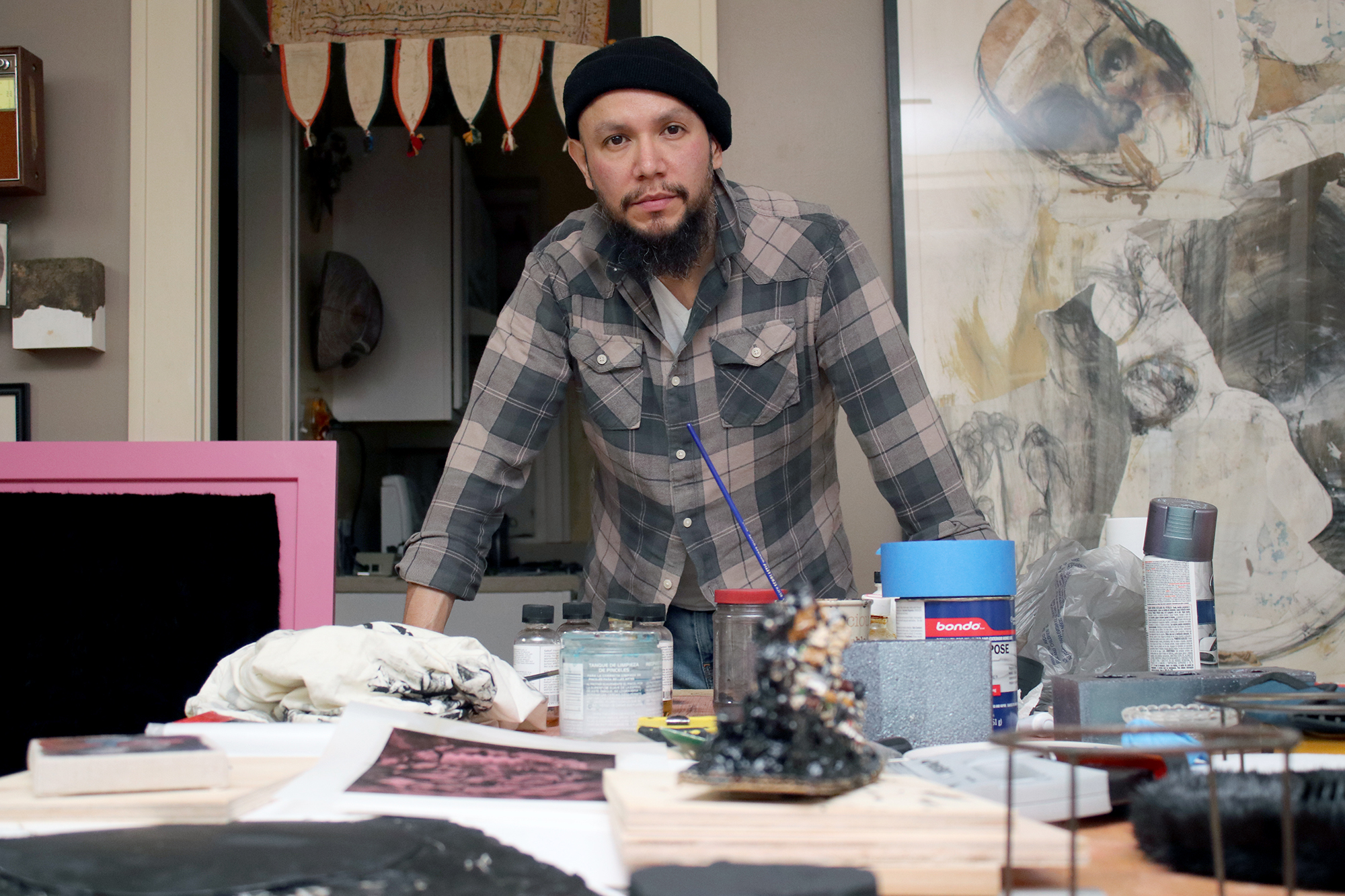Amber Devon Kempthorn constructs characters and narratives in her art by drawing from personal experiences, music and literature
Story by Carlo Wolff
Photography by Michael C. Butz

“Untitled (Camus),” 44 inches by 30 inches; charcoal, pastel and collage. Courtesy of the artist. This piece was exhibited at “The Show,” 1point618 Gallery’s recent 10-year anniversary show.
Amber Devon Kempthorn’s studio on the second floor of the old yellow house she rents from Hiram College is her still center. It’s where she gathers force, immersing herself in inspiration.
There’s a poster of John Wayne, spirited from her dad’s workshop in Cuyahoga Falls. There’s a photo of her Uncle Ted, who passed away in recent years. There are quotations from Kempthorn’s voracious reading and her musical musings, spanning the rock group R.E.M. and the mystical Spanish writer Jose Luis Borges. There are the boxes of pastels from which Kempthorn so regularly draws.
There’s more, like old security envelopes she tears up for resonant construction backgrounds, notebooks in which to jot down ideas, paperbacks on pop culture, ticket stubs from old rock ‘n’ roll shows. There’s a field guide to the stars and planets.
This is clutter artfully arrayed for artistic purpose. It speaks of an artist who knows how to organize her influences.
The slim, closely coiffed Kempthorn is preternaturally self-sufficient.
She also is a curious blend of introvert and extrovert. Like her drawings – “constructions,” she agrees, may be a better term – she’s both introspective and engaged.
“I have passages where I’m like, ‘Oh my God, I need to see a human,’ but I’ve always been a non-joiner – but I do like a sense of community,” she says of her sometimes conflicting requirements.
Her style is a scramble of disciplines. There’s a touch of Japanese painting. There’s a touch of Maxfield Parrish, too, and of the psychedelic pop art of the 1960s.
The art, like the artist, is also profoundly, even paradoxically, Midwestern. It’s both dreamy and solid.
“There are some artists who see a whole other universe and feel the need to fill it right there, like make a thing out of thin air,” Kempthorn says. “I’m not that. I’m a builder.”
And a creator of character.
Take “Sorrow,” a pastel, graphite, ink and collage piece Kempthorn exhibited at a major solo show in 2010 at Robert Maschke’s 1point618 Gallery in Cleveland’s Gordon Square Arts District. (It now hangs on her studio wall.) It’s based on a song of that name by indie rockers The National.
The singer says, “‘Sorrow found me when I was young/sorrow waited, sorrow won.’ Depression, however you want to describe it,” Kempthorn explains. “Sorrow … becomes almost bodily, right? Or anthropomorphic, or it’s a figure – like a specter waiting around. So I made a character named Sorrow.”
Is that character – a deep blue octopus-like creature with a jagged, toothy grin – sad? “He’s about to drown these guys, he’s real pleased with himself,” she says, suggesting otherwise while invoking the Blue Meanies of “Yellow Submarine” fame. “Everything gets kind of dumped in there.”
Now “Sorrow” is more than a National song. It’s an Amber Devon Kempthorn story.
Character development
Kempthorn began working when she was 15 after school, at a coffee shop in Cuyahoga Falls, her hometown. “It was the sensible thing to do,” she says. “I wanted a car, I wanted a job.”
At the same time, she pursued her art. Couldn’t help it.
“I made drawings. I made things, always. I love to draw, love, love, love to draw, always,” she says. Her father is a tinkerer, a chemical engineer by profession; her mother is retired from the Ohio Department of Natural Resources. Her younger sister, who is working toward a master’s degree in counseling at Johns Hopkins University in Baltimore, has been a major support, she says.
As a kid, Kempthorn wrote a lot, entering Hiram College as an English major in 1996. That year, she also became involved in social issues, designing her own major and traveling to Guatemala when it held its first democratic elections.
She went on to earn a Bachelor of Arts degree from Hiram in 2000, a post-baccalaureate certificate from the Maryland Institute of Art in 2006, and a Master of Fine Arts degree in sculpture from the Cranbrook Institute of Art in Bloomfield Hills, Mich. in 2008. Though her MFA is in sculpture, she now works in two dimensions, creating artwork of some size; 44 by 30 inches is her sweet spot.
George Schroeder, an emeritus professor of art at Hiram whom Kempthorn considers a mentor, spoke highly and critically of his former pupil.
“Amber is as smart and well read as any artist I know,” he says in an email. “She is also assertive, dedicated, and tenacious. Her tenacity could also be described as grit: after college she worked for years as a waitress and seasonal farm worker while developing a portfolio strong enough to get her admitted to Cranbrook.
“She was a demanding student. She took her education seriously. We sometimes butted heads but overall she was a joy to have as a student because she took it all so seriously and tried to take in as much as she possibly could.
“As a teacher of upper level students, my emphasis was on formal, i.e. design, integrity and energy, truth to materials, and sound craftsmanship. I think Amber has internalized this, whether she got it from me or somewhere else – I wouldn’t presume to claim credit – as she has moved on to an emphasis on narrative and symbolic themes.”
Kempthorn’s unique talent, according to Schroeder, also extends to her teaching, which she considers another opportunity for storytelling. Kempthorn is a member of the adjunct faculty at both the Cleveland Institute of Art and the College of Wooster.
Her work has been featured in galleries in Boston and Burlington, Vt. and she has exhibited all over Greater Cleveland, including multiple times at 1point618. The most recent was earlier this year as part of the gallery’s 10-year anniversary show, where Schroeder’s art was also on display.
“We’ve been showing Amber for almost 10 years,” says 1point618’s Maschke. “I think Amber’s a storyteller. She’s telling stories of her life through these creative characters.”
Maschke suggests Kempthorn has effectively created her own medium. “Amber’s building all these layers, but she’s telling a story,” he says, adding her art sells well and including her among the leading contemporary artists in Cleveland’s burgeoning scene.
“It probably sounds like hubris but I’ve got to have millions or thousands of stories,” Kempthorn says.
She’s worked with homeless and for an AIDS task force. She’s worked on a farm and at a gas station. She has traveled, she’s well-read and she networks like a champ. She gets around, blasting Springsteen as she drives. She’s lived in Baltimore, Charlotte, N.C. and Boulder, Colo. But Ohio is very much her home.
Narrative techniques
Back in Hiram, her place is bucolic, the aromas of nature heady. On an early evening in early September, the atmosphere is as drowsy as the fireflies sparking the greens around her home. Her residence is conducive to reflection and reverie, particularly in a late-summer landscape in which the blue, green and gold she says characterize Ohio summers are so intense.
Those colors figure in many of the Kempthorn conflations. Others – oranges, pinks, beiges, reds – are similarly vivid and, for the most part, similarly soft. Her art is all about texture, about working the material down so it amasses a singular, almost subterranean heft.
When she lays pastel and charcoal, she breaks down the raw sticks “to the point where I’m just embedding them in the surface for sometimes hours to get the surface I want or the fade – I’ll move from a dark blue to a light blue, laying down the different colors to get me there.” There can be drawing; there can be the laying in of those security envelope backgrounds, as at the top of “Sorrow.”
The veins she mines are deeply personal.
“My work derives from an impulse to create and also from a compulsion to speak,” Kempthorn says in her artistic statement. “In Joan Didion’s The White Album, she wrote that, ‘We tell ourselves stories in order to live.’ To me, she is describing our very human need to document our lives, and how sharing stories acts as a salve for everything from the everyday bruises to the larger burden of existence.”
The loss of a loved one leaves an ache. It can also inspire.
Kempthorn speaks of Uncle Ted, a favorite of hers, whose death from liver failure in 2010 sparked a burst of creativity.
“He died and I ended up making a sort of a cycle of drawings that had to do with him. He was a real hard-ass, was a heavy drinker.
“In my family, on both sides, there’s all kinds of mental illness. … I have my own dark passages, you know? But my parents, they also were very …” she ruminates. “They’re both very engaged with living, they’re very active, very involved, doing things.”
In Kempthorn’s art, there’s a sunniness. But darkness lurks. Though delicate and precise, her work also evidences gravity. This is not frivolous art, no matter how entertaining and provocative.
Kempthorn’s recollection of Christmas is an example of that shadowplay. It was always a special time for her and her family, and a tradition she keeps to this day, inviting her students into her home to celebrate the holiday. But a heaviness accompanied those celebrations.
“There was always a real sense of wonder in my life (at Christmastime),” she adds, but it’s “counterbalanced by a lot of this other, darker stuff.”
Kempthorn’s art, psychologically complex and absorbing, creates a sense of wonder, defying you to stop looking. CV
*Lead image: Amber Devon Kempthorn lines the walls of her Hiram studio with artistic inspiration.














